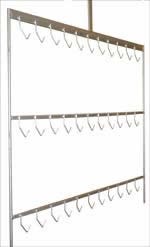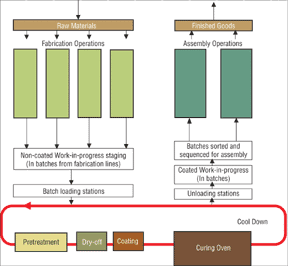Developing Racking and Production Strategies for Powder Coating
Racking is an under-appreciated - and often neglected - aspect of powder coating. This article looks at the role that racking plays in the development of a production strategy...
Rodney Dangerfield, one of my favorite stand-up comedians, died recently. He was made famous for the saying: “I get no respect.” Racking has often been referred to as the “Rodney Dangerfield” of the coating system components, since it rarely receives the respect it deserves. It seems all too common to see a new coating system installed and ready to operate with few or no plans and provisions in place for racking the product to be coated.
Racking should be considered a critical part of any coating system project, one which deserves the respect of the project planner and manager. In the strategic planning phase, the primary question is “What do we want this coating system to do?” The answers to that question are the guiding factors for the overall system design. Another question we might ask during the early planning stages of a coating system project is “What do we want the racking to do?”
In order to have a successful project, racking considerations must play a key role. However, racking is a large subject and the approach that one takes to it varies with the application. Racking is a highly integrated support function with many aspects. Consequently, finding a place to start can be difficult. Perhaps that is why so little has been written about the subject.
For the purpose of this discussion we will look at the role that racking played in a recent concept study I was involved in. This was a study of how to best integrate a powder coating installation into a new production plant.
The product being manufactured is a consumer lawn care product containing several metal components. All of the components are to be fabricated, coated and assembled in the same production facility. The projected volume was sufficient to support a sophisticated production line. Color and durability requirements were such that powder coating was the logical coating technology to be used.
The primary strategic question was asked. “What do we want this coating system to do?” The planning team decided to consider two possible operational strategies for integrating the powder coating system in between the fabrication and assembly functions. This decision was very important because it would have a dramatic effect on the layout and operation of the plant. The decision would also affect the material flow through the plant, the type of racking needed and how the powder coating system would operate.
Operational Strategies:
The planning team focused on two strategies for integrating the coating operation into the manufacturing operations. They were designated as “synchronous” and “batch” strategies. We will discuss each of these strategies and the role that racking plays within them.
The synchronous strategy. Some of the team members thought it might be more beneficial to have the coating operation support the production of the components it coats on a synchronized basis. That is, as the product components are fabricated, they are immediately placed on a rack and conveyed all the way to and through the coating operation and then on to the assembly function. The key element here is a continuous closed-loop conveyor system.
The batch strategy. Other team members preferred the concept of having the production of components support the coating operation. That is, as the components are fabricated they are transported to the coating operation in production lots or batches. The components are placed on racks in batches of like parts and conveyed through the coating operation. After being coated, they are then transported to the assembly operations or the next phase of the process as appropriate.
The team considered some of the advantages and disadvantages of each of these operational strategies. It also looked at how each strategy would affect the possible racking requirements. Let's look at some of the findings of their study.
The Synchronous Strategy
Synchronizing the fabrication, coating and assembly operations can be accomplished today with automated systems. The parts can be programmed to arrive at a central conveyor line at the correct rate to ensure that the right number of parts are available for loading as “assembly kits” on the conveyor. The parts are loaded and unloaded one time, thereby minimizing handling labor. This approach will virtually eliminate the floor movement of work-in-process inventory. The conveyor acts as the transport device as well as the staging area for the work-in-process (Figure 1).
A customized racking system is usually used to support this strategy. With a custom rack, the parts can be loaded onto the conveyor in “kits,” allowing for all of the fabricated product components (that will be coated) to be placed on one rack.
Considerations for the synchronous strategy were:
• Special conveyor requirements
• A long and complex conveyor
• Rack requirements
• Product mix
• Production plant layout
• Varying component production rates
• Coating line use
• Labor requirements
• Plant space use
Special conveyor requirements could be a major factor. For example, in order to provide some level of flexibility for the coating operation it might be necessary to use the “power-and-free” conveyor design instead of just a monorail conveyor. If a long conveyor—and perhaps multiple accumulation stations—would be required, this could generate a much higher conveyor cost.
ant. To deal with this situation, the smaller parts will require organized staging areas near the conveyor line where they can be loaded to a customized rack as required for each kit.
Coating line use will be adversely affected by the synchronous strategy. The powder coating systems will have more capacity than the production operations it supports. The rate of production for the powder coating line will be governed by the production rate of the plant.
Labor requirements for racking and material handling will be optimized. The fabricated components will be loaded onto the line and will not be handled again until they are removed for assembly.
Plant space use will also be optimized. The racked parts can be conveyed overhead for movement and staging thereby saving space that might be used for aisles and placement.
We often see the synchronous strategy being successfully deployed when manufacturing operations within a plant are geared to the support of the assembly of a limited product line. When we replace the surface movement of work in process with overhead conveyance, we add to the racking considerations. However, this method of executing the synchronous strategy does a lot of good things for safety, plant congestion, floor space use and production coordination.
On the other hand, the custom racking needed to coat parts as a kit presents some unique challenges for powder coating. It is not enough to just make sure there is a place on the rack for every part in the kit. The parts must be positioned for powder coating as well.
The Batch Strategy
The company's standard practice had been to send the fabricated components to a job shop to be coated and then on to assembly operations upon their return. The batch strategy was appropriate for this procedure, and the team was familiar with it. The team looked at the concept as though the powder coating system would just replace the coating job shop within their new facility (Figure 2).
The issues that were then studied for the batch strategy included:
- Standardized racking systems
- Simplified conveyor design
- Product mix
- Varying component production rates
- Coating line use
- Surface movement requirements
- Labor requirements
- Plant space use
Standardized racking systems are available from several commercial sources. The team discovered designs that were very efficient for the interchange of hooks and devices to accommodate different part configurations. The racks are also uniquely designed to protect the contact points to maintain optimum grounding.
Simplified conveyor design could be used. Racking considerations for a straight monorail conveyor can still have the flexibility for adjustments to accommodate higher densities of certain part configurations. The length of the conveyor will be much shorter. It will only need to convey the parts through the powder coating system and will not extend to the fabrication and assembly areas. The cost per foot will also be considerably lower and maintenance will be simpler.
Product mix would not be as much of an issue. Racking adjustments can be more easily made for different component configurations on a batch by batch basis.
Varying component production rates will not be a problem. Racking configurations can be easily modified to accommodate production variations. The powder coating line will be scheduling the components independently and, as they become available.
Coating line use will be more efficient and flexible. With good racking techniques, a powder coating line can often process parts faster than they can be fabricated. This might provide excess labor time for material handling, quality functions and plant cleaning and maintenance.
Surface movement requirements will be a major difference. With the batch strategy all fabricated components must be transported across the plant floor to the finishing system for coating. After coating, the components must be sorted, sequenced for assembly and then be transported to the assembly area.
Labor requirements could be higher with a batch strategy.
Components must be handled at least two more times to accommodate the surface movement to and from the powder coating line. However, the team identified possible offsets of labor requirements due to improved racking efficiency. One study also showed reduced motion requirements by simply placing the components in the bin for movement rather than waiting to position them on the rack. Additional labor will also be required to operate lift trucks and maneuver bins containing work-in-process.
Plant space use was considered less efficient with this strategy. Floor space will be needed for aisles and work-in-process staging areas. More floor traffic would be required as lift trucks move containers.
Selecting the Strategy
The decision that was made in the concept study and discussion above was determined by adopting an overall production strategy. That strategy was to dedicate this plant to a specific product line since the projected volume was sufficient to support it. With that decision, many variations were eliminated. The team calculated that the savings in labor and improved plant space use justified the additional capital investment. Therefore, they decided to install a sophisticated power-and-free conveyor system. The team also commissioned a company that specializes in racking systems to design custom racking and to supply the production racks.
Throughout the concept study, this planning team showed a lot of respect for the role that racking plays in the production planning process.
Read Next
Episode 45: An Interview with Chandler Mancuso, MacDermid Envio Solutions
Chandler Mancuso, technical director with MacDermid Envio discusses updating your wastewater treatment system and implementing materials recycling solutions to increase efficiencies, control costs and reduce environmental impact.
Read MoreEducation Bringing Cleaning to Machining
Debuting new speakers and cleaning technology content during this half-day workshop co-located with IMTS 2024.
Read MoreA ‘Clean’ Agenda Offers Unique Presentations in Chicago
The 2024 Parts Cleaning Conference, co-located with the International Manufacturing Technology Show, includes presentations by several speakers who are new to the conference and topics that have not been covered in past editions of this event.
Read More



















.jpg;maxWidth=300;quality=90)



